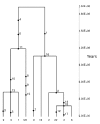A complex selection signature at the human AVPR1B gene
- PMID: 19486526
- PMCID: PMC2700802
- DOI: 10.1186/1471-2148-9-123
A complex selection signature at the human AVPR1B gene
Abstract
Background: The vasopressin receptor type 1b (AVPR1B) is mainly expressed by pituitary corticotropes and it mediates the stimulatory effects of AVP on ACTH release; common AVPR1B haplotypes have been involved in mood and anxiety disorders in humans, while rodents lacking a functional receptor gene display behavioral defects and altered stress responses.
Results: Here we have analyzed the two exons of the gene and the data we present suggest that AVPR1B has been subjected to natural selection in humans. In particular, analysis of exon 2 strongly suggests the action of balancing selection in African populations and Europeans: the region displays high nucleotide diversity, an excess of intermediate-frequency alleles, a higher level of within-species diversity compared to interspecific divergence and a genealogy with common haplotypes separated by deep branches. This relatively unambiguous situation coexists with unusual features across exon 1, raising the possibility that a nonsynonymous variant (Gly191Arg) in this region has been subjected to directional selection.
Conclusion: Although the underlying selective pressure(s) remains to be identified, we consider this to be among the first documented examples of a gene involved in mood disorders and subjected to natural selection in humans; this observation might add support to the long-debated idea that depression/low mood might have played an adaptive role during human evolution.
Figures





Similar articles
-
Evidence of an association between the vasopressin V1b receptor gene (AVPR1B) and childhood-onset mood disorders.Arch Gen Psychiatry. 2007 Oct;64(10):1189-95. doi: 10.1001/archpsyc.64.10.1189. Arch Gen Psychiatry. 2007. PMID: 17909131
-
Family-based study of AVPR1B association and interaction with stressful life events on depression and anxiety in suicide attempts.Neuropsychopharmacology. 2013 Jul;38(8):1504-11. doi: 10.1038/npp.2013.49. Epub 2013 Feb 19. Neuropsychopharmacology. 2013. PMID: 23422793 Free PMC article.
-
A population genetics study of the familial Mediterranean fever gene: evidence of balancing selection under an overdominance regime.Genes Immun. 2009 Dec;10(8):678-86. doi: 10.1038/gene.2009.59. Epub 2009 Aug 13. Genes Immun. 2009. PMID: 19675583
-
Polymorphisms in the CPB2 gene are maintained by balancing selection and result in haplotype-preferential splicing of exon 7.Mol Biol Evol. 2010 Aug;27(8):1945-54. doi: 10.1093/molbev/msq082. Epub 2010 Mar 17. Mol Biol Evol. 2010. PMID: 20237223
-
An evolutionary history of the selectin gene cluster in humans.Heredity (Edinb). 2012 Aug;109(2):117-26. doi: 10.1038/hdy.2012.20. Epub 2012 May 2. Heredity (Edinb). 2012. PMID: 22549518 Free PMC article.
Cited by
-
Complex interplay of evolutionary forces in the ladybird homeobox genes of Drosophila melanogaster.PLoS One. 2011;6(7):e22613. doi: 10.1371/journal.pone.0022613. Epub 2011 Jul 22. PLoS One. 2011. PMID: 21799919 Free PMC article.
-
Oxytocin and arginine vasopressin systems in the domestication process.Genet Mol Biol. 2018;41(1 suppl 1):235-242. doi: 10.1590/1678-4685-GMB-2017-0069. Epub 2018 Mar 26. Genet Mol Biol. 2018. PMID: 29668014 Free PMC article.
-
Searching for ancient balanced polymorphisms shared between Neanderthals and Modern Humans.Genet Mol Biol. 2018 Jan-Mar;41(1):67-81. doi: 10.1590/1678-4685-GMB-2017-0308. Genet Mol Biol. 2018. PMID: 29658973 Free PMC article.
-
Glutamate-specific gene linked to human brain evolution enhances synaptic plasticity and cognitive processes.iScience. 2024 Jan 19;27(2):108821. doi: 10.1016/j.isci.2024.108821. eCollection 2024 Feb 16. iScience. 2024. PMID: 38333701 Free PMC article.
-
Genomic Signatures of Positive Selection in Human Populations of the OXT, OXTR, AVP, AVPR1A and AVR1B Gene Variants Related to the Regulation of Psychoemotional Response.Genes (Basel). 2023 Nov 8;14(11):2053. doi: 10.3390/genes14112053. Genes (Basel). 2023. PMID: 38002996 Free PMC article.
References
-
- Volpi S, Rabadan-Diehl C, Aguilera G. Vasopressinergic regulation of the hypothalamic pituitary adrenal axis and stress adaptation. Stress. 2004;7:75–83. - PubMed
MeSH terms
Substances
LinkOut - more resources
Full Text Sources
Miscellaneous

